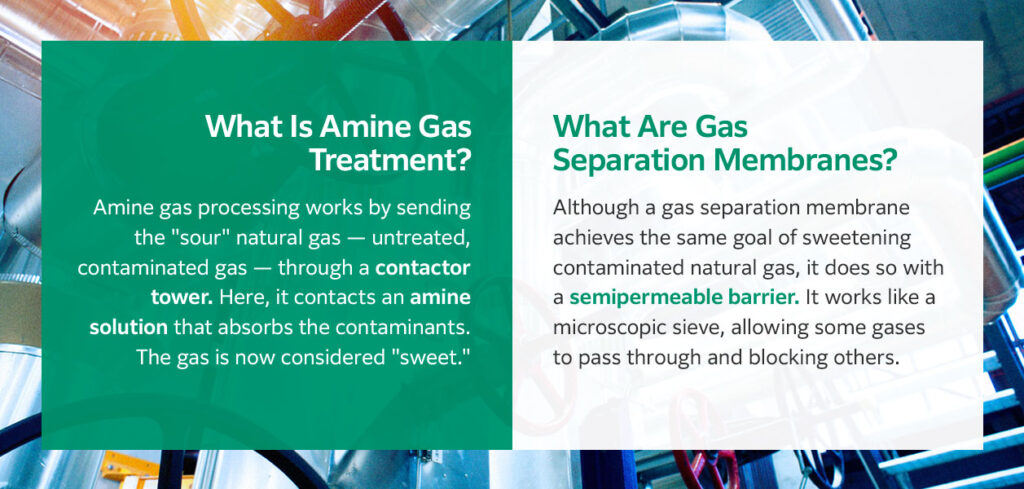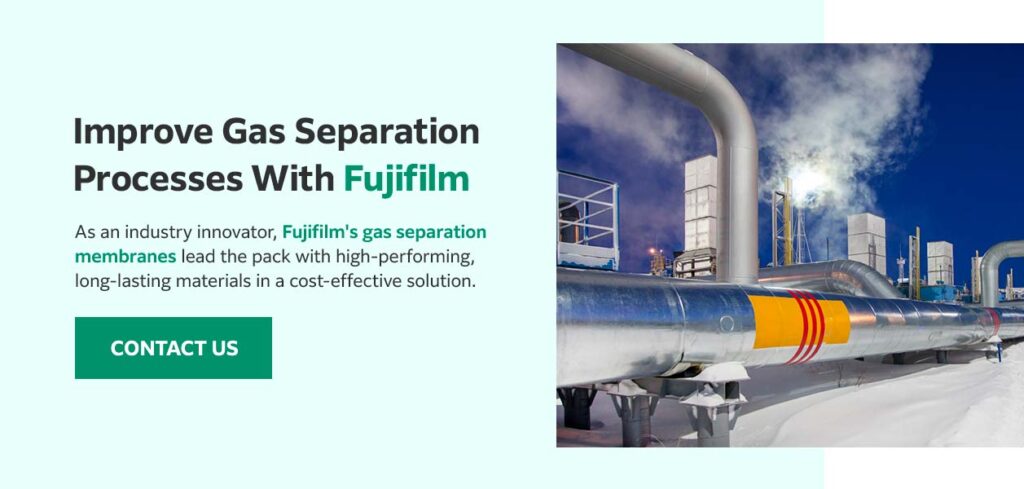
Jump to:
- What is Amine Gas Treatment?
- What Are Gas Separation Membranes?
- Amine Gas Treatment vs. Gas Separation
- Best Applications
Thanks to modern technology, natural gas treatment can occur in several different ways. Two of the most popular options are amine gas treatment and gas separation membranes. One relies solely on chemicals, while the other introduces a mechanical element to help remove unwanted components like carbon dioxide (CO2) and hydrogen sulfide (H2S). Depending on the application, these components can make a gas supply unsuitable for use due to their corrosive and toxic properties. Oil and gas companies must remove them to meet various standards and protect equipment.
While both options can help achieve a clean natural gas supply, choosing the right one can also ensure a cost-effective, eco-friendly operation with minimal labor requirements.
What Is Amine Gas Treatment?
Natural gas amine treatment processes remove CO2 and H2S from incoming natural gas streams and make the gas suitable for transportation and use. If these contaminants remain in the gas stream, they can damage equipment or cause noncompliance with standards.
Amine gas processing works by sending the “sour” natural gas — untreated, contaminated gas — through a contactor tower. Here, it contacts an amine solution that absorbs the contaminants. The gas is now considered “sweet.” It becomes saturated with water during this process, so it goes through a separate dehydration process before heading to the pipeline.
The gas is treated and ready to move on at this point, but the amine system has more work to do. The amine solution must go through regeneration, where heat causes the solution to release the CO2 and H2S that it absorbed in the previous step. The water-saturated acid gases then get cooled, condensed, separated and sent back to the regeneration still for the process to start over.
Users can choose from different types of amines best suited to the application and the characteristics of the incoming natural gas. When these amines degrade, they turn into amine salts, which require disposal at approved facilities.

What Are Gas Separation Membranes?
Although a gas separation membrane achieves the same goal of sweetening contaminated natural gas, it does so with a semipermeable barrier. It works like a microscopic sieve, allowing some gases to pass through and blocking others. The tube-shaped membrane comprises specialized polymers that allow feed gas to cross the barrier and enter a permeate collecting pipe. This pipe sits in the middle of the membrane and carries off the gas that moved through the membrane.
Gas separation membranes can:
- Remove water, H2S and CO2 from natural gas
- Remove volatile organic compounds (VOCs) from nitrogen or air streams
- Condition fuel gas
- Separate hydrogen
- Remove nitrogen from air
Membranes typically comprise dense polymers, but the exact makeup depends on many factors like pressure, temperature and contaminant types. Some molecules move at different speeds or behave differently in various environments. You can even adjust the selectivity of a membrane by tuning its permeability for different molecules and environments.
Amine Gas Treatment vs. Gas Separation
Both amine gas treating and membrane separation can offer effective gas sweetening, but their differences can significantly affect the performance of a gas sweetening operation. Some of the ways amine treatment and gas separation differ include the following:
- Labor and disposal requirements: Amine solutions degrade into amine salts, waste products that workers must transport to disposal sites. Since they don’t use amines, gas separation membranes don’t have these requirements. They also don’t have moving parts that require extensive maintenance and repairs.
- Cost: Gas separation membranes are much more economical in the long run, with lower capital and operating expenditures. Fewer components simplify the system, minimizing repairs and maintenance and preventing downtime due to mechanical failures. Since there are no supplies to replenish, users can save significantly on materials, transportation and labor costs.
- Process intensification and debottlenecking: Both systems effectively reduce contaminants to low parts-per-million (PPM) values, but amine gas treating processes can achieve extremely low contaminant concentrations, meaning it’s necessary for some industries and applications. Membrane systems can help meet moderate treatment needs or complement an amine system to reduce the demand placed on it.
- Safety and environmental impact: Amine treatment can involve VOCs, hazardous chemicals and combustion risks. Gas separation doesn’t require these chemicals, significantly improving worker safety and health and eco-friendly operations.
- Size: Amine treatment systems can be complex and require additional components, such as dehydration units. Membrane systems are compact and contained in a modular, skid-mounted unit, making them more suitable for smaller sites. They’re easier and faster to install, too, reducing downtime.
Although they share the same goal, gas separation membranes have emerged as a capable technology with significant benefits over amine gas treatments.
Best Applications
These two technologies typically perform best in specific applications, helping users meet particular demands with high operational efficiency.
Gas separation membranes are well-suited to:
- VOC and heavy hydrocarbon removal
- Fuel gas conditioning for gas turbines and engines
- Wellhead natural gas conditioning
- Bulk H2S removal in fuel gas
- Synthesis gas
- Operations in remote locations
- Separating H2 from larger molecules
- Applications that require high selectivity
Although amine treatment is effective, it lacks the many benefits of gas separation, like cost savings and installation flexibility. Membrane technology is the best option for businesses looking to get ahead of emissions standards and safety requirements.
If an application needs to meet especially strict standards, amine gas processing may be necessary due to its high removal capabilities. However, you can still reap the benefits of a separation membrane by placing one upstream of an amine system. Membranes can complement amine systems by removing the majority of contaminants before sending the natural gas supply to the amine process, which finishes the job with more contaminant removal. The amine treatment then requires less solution and processing, reducing hazardous emissions and expenses.
While this approach won’t eliminate the need for amine treatment, it can significantly reduce the demand placed on the amine system. With less demand, oil and gas companies can minimize the costs, mechanical strain and labor requirements associated with amine systems for a more efficient, affordable treatment process. This hybrid approach is also a great way to transition to separation membranes and still maximize the value of existing amine systems.
Improve Gas Separation Processes With Fujifilm
As an industry innovator, Fujifilm’s gas separation membranes lead the pack with high-performing, long-lasting materials in a cost-effective solution. Choose from Apura™️-FG for efficient fuel gas conditioning, Apura™️-1.5XF for maximum CO2 removal and Apura™️-2.0C for hydrocarbon recovery. Our experienced team can help you build the right solution.
To chat with a gas treatment expert, please reach out to us today!














